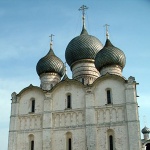Sights Rostov, Russia
 Significant past Rostov resulted in its richness of historical and cultural monuments. One of the most important monuments is the very landscape of the lake basin and adjoining territory for thousands of years attracted people and full of archaeological sites.
Significant past Rostov resulted in its richness of historical and cultural monuments. One of the most important monuments is the very landscape of the lake basin and adjoining territory for thousands of years attracted people and full of archaeological sites.Classic not only of Russian, but also of world art and architectural monuments of Rostov steel, in particular the construction of the former home of the Bishops in XVII. - Rostov Kremlin. The Kremlin is divided into three zones: the bishop's court, and the Metropolitan Cathedral Square Garden. The main dominant of the ensemble of the Kremlin and the whole city is the Cathedral of the Assumption, built in 1508-1512 on the site of their predecessors. Most of the buildings of the Kremlin were built much later than the cathedral, during the reign of Metropolitan Jonah. According to his plan of about 1682 was built by the quadratic belfry. When Jonah Sysoevicha 13 bells were cast. Largest - Sysoy "- cast in 1687 by master Fyodor Terentyev and weighs about two thousand pounds," Polieleyny "- a thousand pounds," The Swan "- 500 pounds. Rostov chimes have special names. The most ancient - an alternate ringing all the bells on the background sound of the big bell "Syso." At the time of Peter I appeared Yegorievsky ringing in 1731 - Akimov ringing in the 19 century - Ionofansky. The most solemn ringing - Ionic.
Among the buildings of the bishop of the Kremlin, one of the first hull was built by order (1650-1660). Around 1670 close to the ship being built by order Gate Church of the Resurrection with two towers. The entire complex has formed the main entrance to the Metropolitan Court - the Holy Gate. On the other side of the central courtyard housing towering metropolitan chorus (1650-1670). Khoromy repeatedly rebuilt and restored. In the same breath with them is complex Gosudarskih chorus (1670-1680), who later became known as the "Red Chamber." Around 1675 mansion built for the Metropolitan Church of the Image of the Savior (later - the Savior on the porch). Church of Our Savior is the home church, Metropolitan Jonah.
Over the 1670-1680 period were built walls and towers of the Rostov Kremlin, economic structures (metropolitan) court. One of the last buildings of the time Jonah was the Gate Church of St. John the Divine (1638). Compared with other churches, the archbishop's court of the temple Gregory the Theologian (1680-e gg.) Preserved by Grigor'ev shutter seems understated. The final construction of the Kremlin became church Odigitrii (1692-1693). Assigned to the features of the Temple "Naryshinsky style, but unlike most of the structures of the direction the church Odigitrii looks modest. Formation of the archbishop's court was completed by the end of 17 century. Most of the buildings of the ensemble are museum-reserve "Rostov Kremlin".
Most valuable is the stone and wooden buildings of the city XVIII-XX centuries. Heritage of World Culture are Rostov chimes - a unique set of musical works XVII-XIX centuries., Inseparable from the wonderful musical instrument - the famous Rostov belfry. Each of its 13 bells, from the largest, weighing 2 thousand tons (32 tons), to the very small, has its own sound.
On the western outskirts of the city on the shores of Lake Nero, location is a beautiful ensemble Savior Yakovlevskogo monastery. Panorama Savior Yakovlevskogo monastery with beautiful combination of different styles of architectural forms - the pseudo-end towers, Baroque and classical completion of Churches - gives the impression of the fantastic miracle of the city, perfectly located in the lakeside landscape.